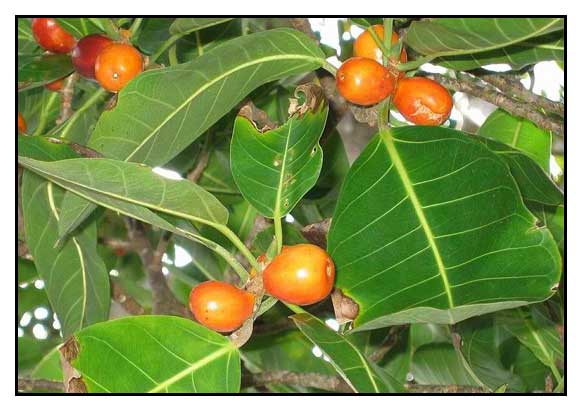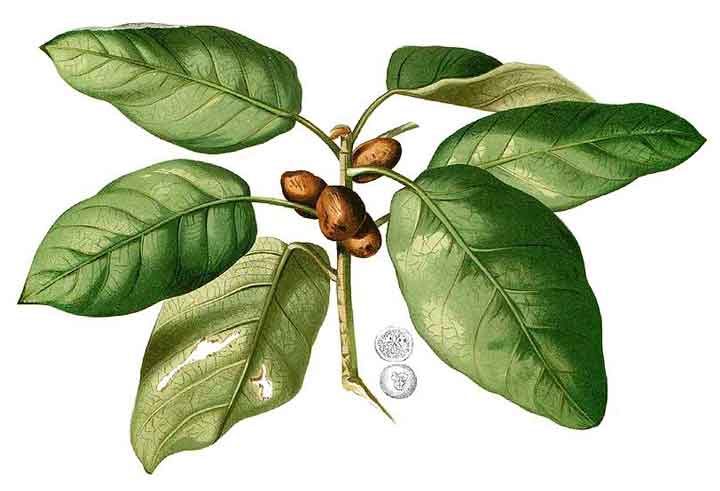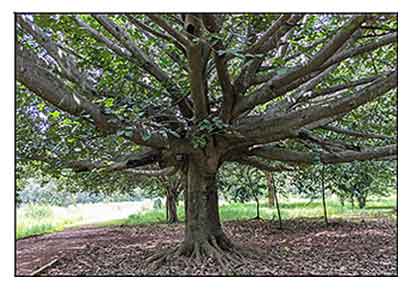
Family • Moraceae
Payapa
Balete
Ficus drupacea Thunb.
BROWN WOOLLY FIG
Zhen guo rong
| Scientific names | Common names |
| Ficus aurantiicarpa Elmer | Balete (Ig.) |
| Ficus chrysochlamys K.Schum. & Lauterb. | Basakla (Ilk.) |
| Ficus chrysocoma Blume | Dalagit (Bis.) |
| Ficus citrifolia Willd. | Dalakit (C. Bis.) |
| Ficus drupacea Thunb. | Lañgaban (Mag.) |
| Ficus drupacea var. aurantiicarpa (Elmer) Corner | Nonok (Bis., Tak.) |
| Ficus drupacea var. glabrata Corner | Payapa (Tag.) |
| Ficus drupacea var. mysorensis (Roth) M.R.Almeida | Puos (Itn.) |
| Ficus drupacea var. pedicellata Corner | Puspus (Ilk.) |
| Ficus drupacea var. pubescens (Roem. & Schult.) Corner | Brown wooly fig (Engl.) |
| Ficus drupacea var. subrepanda (Wall. ex King) D.Basu | Drupe fig (Engl.) |
| Ficus ellipsoidea F.Muell. ex Benth. | Hairy fig (Engl.) |
| Ficus gonia Buch.-Ham. | Mysore fig (Engl.) |
| Ficus indica L. | Payapa fig (Engl.) |
| Ficus mysorensis Roth | |
| Ficus mysorensis var. dasycarpa (Miq.) M.F.Barrett | |
| Ficus mysorensis f. parvifolia Miq. | |
| Ficus mysorensis var. pubescens Roem. & Schult. | |
| Ficus mysorensis var. pubescens (Roth) King | |
| Ficus mysorensis var. subrepanda Wall. ex King | |
| Ficus payapa Blanco | |
| Ficus pilosa Reinw. ex Blume | |
| Ficus pilosa var. chrysocoma (Blume) King | |
| Ficus pubescens Roth | |
| Ficus rupestris Buch.-Ham. | |
| Ficus subrepanda (Wall. ex King) King | |
| Ficus vidaliana Warb. | |
| Urostigma bicome Miq. | |
| Urostigma chrysotrix Miq. | |
| Urostigma dasycarpum Miq. | |
| Urostigma mysorense (Roth) Miq. | |
| Urostigma pilosum (Reinw. ex Blume) Miq. | |
| Urostigma subcuspidatum Miq. | |
| Worldwide there are over 800 species of the genus Ficus (Latin: fig) and of the more than 10 species found in the Philippines, Balete is a shared common name for six of them: (1) Ficus benjamina, salisi (2) Ficus elastica, Indian rubber tree (3) Ficus indica, baleteng-baging (4) Ficus payapa, payapa (5) Ficus retusa, marabutan, and (6) Ficus stipulosa, botgo. | |
| Ficus payapa Blanco is a synonym of Ficus drupacea Thunb. | |
| Ficus drupacea Thunb. is an accepted name. KEW: Plants of the World Online | |
| Other vernacular names |
| CHINESE: Zhen guo rong. |
| KANNADA: Goni-mara. |
| MALAY: Bulu timun (Java). |
| MALAYALAM: Chela. |
| MARATHI: Burali wad. |
| SPANISH: Higuera de Mysore. |
| TAMIL: Sonnai-ala, Kal-ala. |
| VIETNAMESE: Cây Đa lông. |
Botany Distribution
Properties Studies Availability |
© Godofredo U. Stuart Jr., M.D. / StuartXchange |
Updated January 2023 / July 2018 / May 2013
![]()
 |
PHOTOS / ILLUSTRATIONS |
| IMAGE SOURCE: Photograph / Ficus drupacea / © Greg Calvert / Non-Commercial Use / click on image to go to source page / Figweb |
| IMAGE SOURCE: Illustration / File:Ficus pumila Blanco1.203-cropped.jpg / Francisco Manuel Blanco / Flora de Filipinas / Public Domain / Wikimedia Commons |
| IMAGE SOURCE: Photo--Ficus mysorensis / Siddharth Mallya / CC by SA 4.0 / click on image to go to source page / Wikimedia Commons |
Additional
Sources and Suggested Readings |
• |
DOI: It is not uncommon for links on studies/sources to change. Copying and pasting the information on the search window or using the DOI (if available) will often redirect to the new link page. (Citing and Using a (DOI) Digital Object Identifier) |
| List of Understudied Philippine Medicinal Plants |
• |
 |

 Gen info
Gen info Constituents
Constituents Parts used
Parts used